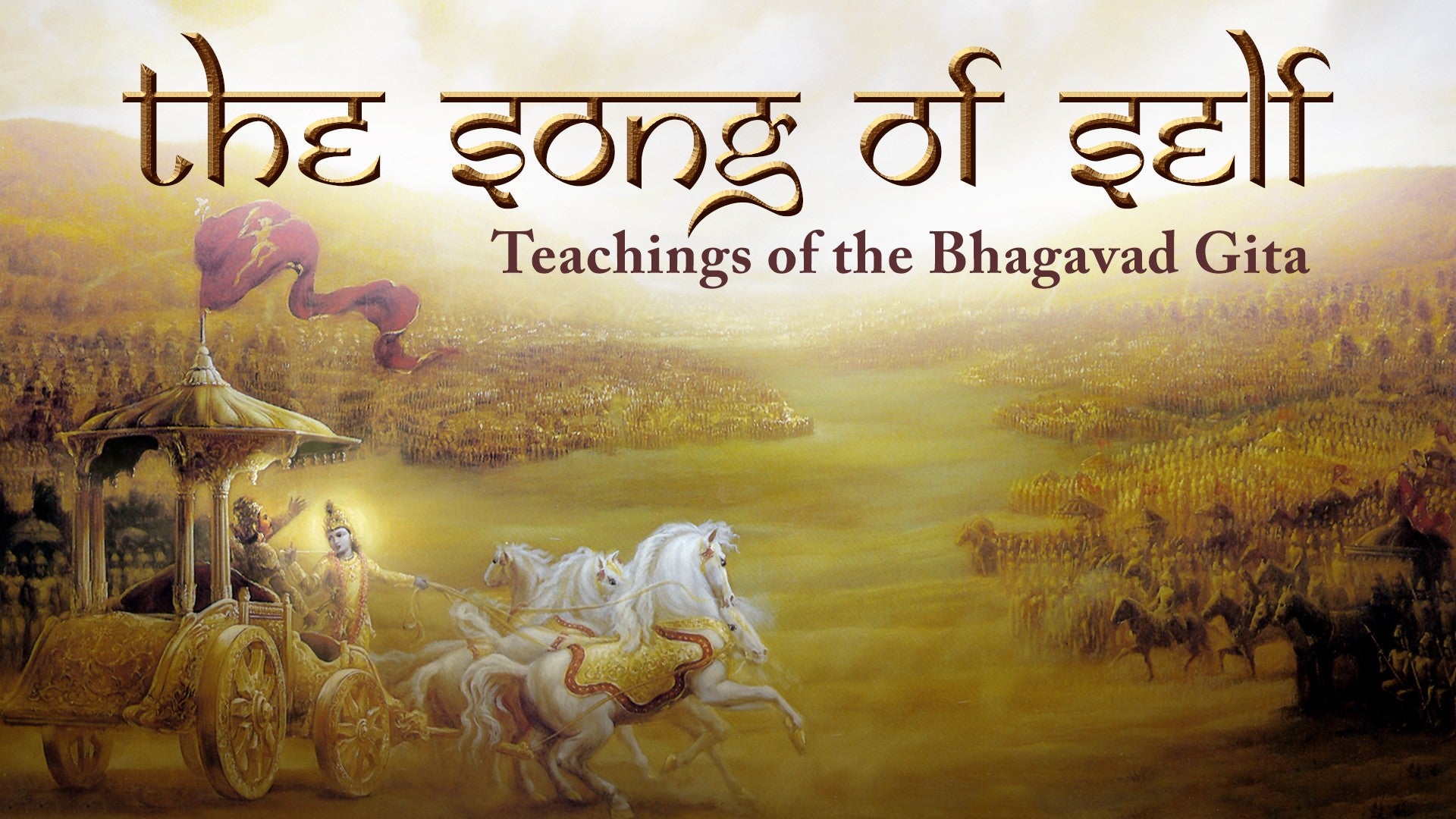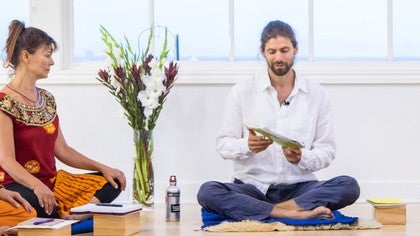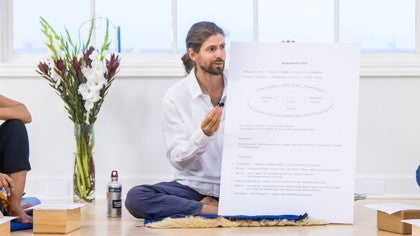Description
About This Video
Transcript
Read Full Transcript
So, my friend Kira, who is actually behind the camera, on her view, she says, well, you know, there's this particular seat you're sitting on, and you always insist on having this bottle with you, and there's this rather seasoned exercise book. So she asked me if I could introduce my props. And it's true that these are the things that I always generally have with me when I do a course on the second chapter of the Gita. This is the second chapter of the Gita, my book that I, this is actually the second time I translated it with my Indian Sanskrit teacher, Alwar, who I previously mentioned. And I'll talk a little bit more about this in a moment.
This generally goes with me always when I teach. And we're going to hear more about this in the course of the second chapter. So you'll hear the background to this particular bottle, which also serves as a very versatile prop and teaching aid. So this might get used now and again, and you'll see as we go. But there's a particular verse where I'll tell you the story of this bottle, but otherwise it'll always be here.
And it's, you might not be able to see this so closely, but this is a sticker from my best friend's yoga space. That's Thomas in Ibiza. And he's like my brother so it's kind of nice to feel some brotherly support when I'm teaching. And we're studying the Gita, and Thomas is actually somebody I consider a truly great yogic warrior. So he works on this island of Ibiza, and some of you may know Ibiza.
It's really quite a particular place with a particular energy. And it takes tremendous commitment to be able to hold the yoga space there, and Thomas has done that for many years. So he's somebody that I hold very dear and who I also admire and respect, and reminds me why I like to share this stuff, because it can be helpful, whatever type of challenge we've got to face in our life. Then my seat, like this is kind of my office that I take with me everywhere I go. For many years I used to sit on one of those rubber asana practice mats folded up.
And it was in 2013 actually, I was teaching in Vancouver, Canada, and I'd gone to give it. It was like a five-day program on Indian mythology, and quite a few different people came over the five days, but there was a small group who attended everything. And nearly all of these people gave me something at the end, and I was very moved. And on the penultimate day, one of the ladies, she had a sheepskin meditation cushion that she'd been sitting on throughout all the classes. And there was like a pause during, we'd finished one session, maybe been a meal break, and we came back.
And some people were there early. And I said, oh, it looks very comfortable. And she said, oh, would you like to try it? May I? And so I sat on it and thought, oh, wow, this is really very comfortable.
And one of the other people noticed that I was really feeling very at home on this sheepskin meditation mat. And the next day at the final class, she said, oh, I have something for you, James. And she presented me with this one. And having seen that I spent quite a lot of time sitting on the ground when I was doing my work, she thought it'd be nice for him to have something more comfortable. And so she called all her monk friends and said, does anybody have a spare sheepskin?
And somebody did. And then this was given to me then. And since then, I found it is much more comfortable than a rubber mat for meditation and for sitting and sharing like we're doing. And then this blue cover was given to me by another dear friend called Radha, who's a wonderful kirtan singer. And in recent years, I spent a lot of time in Mysore, South India.
And so has Radha and her partner Emilio. He plays the mridanga, a percussion instrument. And we often do kirtan together. And one year, Radha went out of India on a visa run to Nepal. And she brought me this back, and I like the color.
So that's the story behind that. And so now we come to the book. So you can see it's seen some use. So I actually first translated chapter two when I used to live in Thailand. And I used to teach at a university there.
I used to teach English. And I was very fortunate because I was becoming very interested in learning Sanskrit. And my office in the English department was on the 11th floor of this arts faculty building. On the 10th floor was Eastern Languages. And there was a Sanskrit section at this university.
And one of my colleagues called Bill, and you'll also hear more about Bill during the course of the second chapter. Bill's a former US Marine who, after experiencing all types of horror when he was serving in Vietnam, turned to the study of philosophy and wisdom traditions. And in his later years, he started to study Sanskrit because he was teaching at the university. And so in his free time, his wife is Chinese, or Thai Chinese. And he worked on Confucius for 25 years before he started doing some Taoist texts.
And with a member of the Thai faculty, he translated Thai Buddhist texts. And with a Japanese colleague, he did some Zen texts. But there came a certain moment where Bill really wanted to do the Gita. So he started studying Sanskrit. And by the time I started teaching at the university, he'd been doing that for a couple of years.
And I knew of that. And when I wanted to start studying, I asked him, do you think that Ajahn Tasani, who was his teacher, would agree also to work with me? And he said, I think she might. So I approached her, but at that time, my teaching schedule was such that I didn't really have enough time to start Sanskrit. But a year or so went by, and I had a lighter teaching load, not as many essays to mark.
And so I started studying Sanskrit, and we did the second chapter. After I spent the previous year struggling through the grammar and passing Ajahn Tasani's tests to be able to start working on texts. And so we did the yoga sutra, actually, first, because that was a bit more accessible from the linguistic point of view. And then we did some Gita, and we started with chapter two. And we'll talk about why we start with chapter two in a little while.
But then a few years later, when I was starting to spend time in Mysore, South India, and my third visit, I started working with Dr. M. A. Alwar, who's been one of my main Sanskrit teachers. And we started with chapter two, and this is the book that as I would prepare, I'd write out the verse. You can kind of see a little bit what it's like if the book doesn't fall complete to thesis. So there's the Sanskrit verse, and then the words when they're in their split form, because sometimes in Sanskrit we join the words. And then there's kind of some grammatical notes, and some pages have got more on them than others.
And so this was the first book I used, and then I kind of had it with me when I would teach. And these days I don't actually look at it that much when I'm teaching the verses, but I generally have it with me in case there's someone I need to check in the grammar. And sometimes I add notes as I go, and over the years as I've taught and worked with more chapters of the Gita, there are many books like this that look much smarter and are so worn. And when I started doing the second chapter with Alois, we'd basically spend, I'd meet him once, sometimes two or three times a day, and for an hour or so we'd do one verse. And so this was kind of where it really kind of started for me, and I started to feel comfortable then to teach from the Sanskrit original, because we'd really kind of look closely at the language and the verses.
And Alois would also share his insights, his understandings of the text, and then we'd discuss it a bit. So this is this book, which you might see in the shot now and again.
The Song of Self: Let's Begin
Comments
You need to be a subscriber to post a comment.
Please Log In or Create an Account to start your free trial.










 thank you James!!!!
thank you James!!!!

